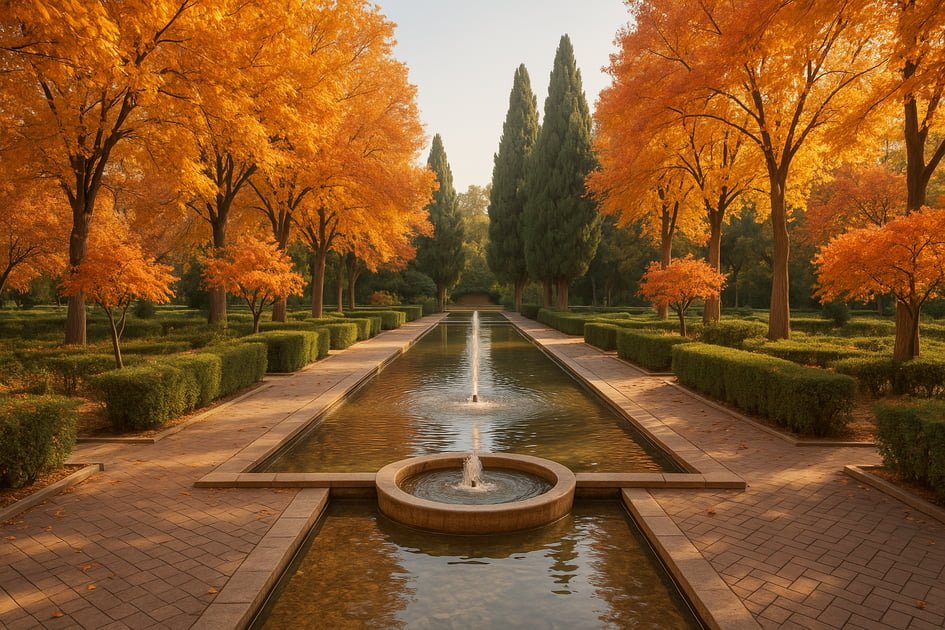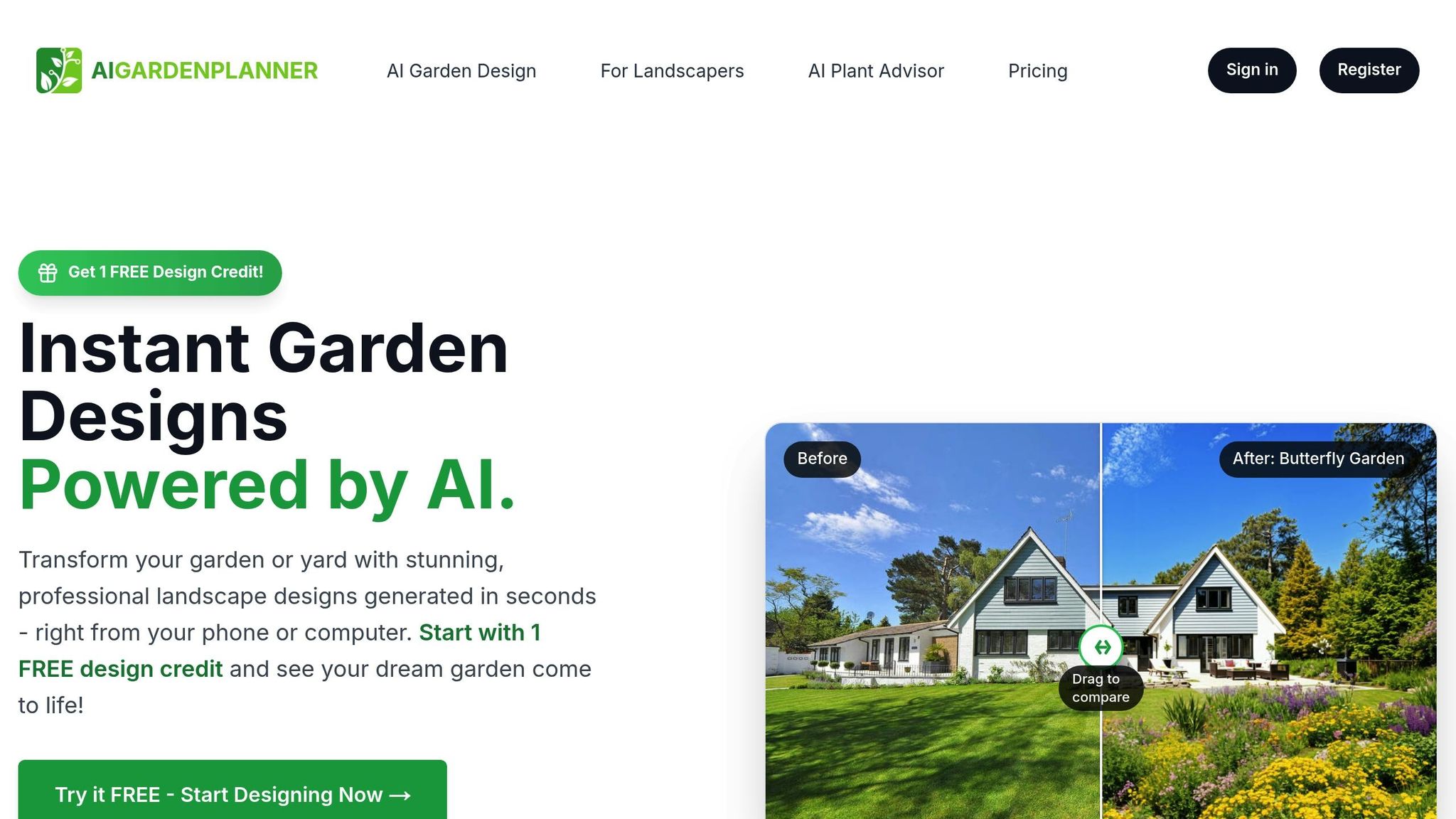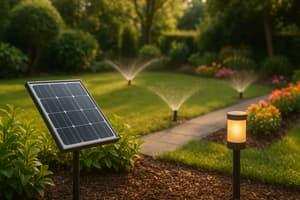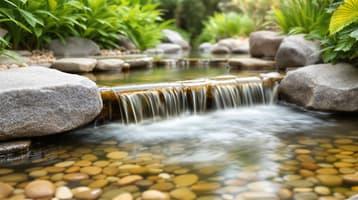How Persian Gardens Adapt to Seasonal Changes

Persian gardens are designed to thrive throughout the year by combining geometric layouts, layered vegetation, and water features that address seasonal challenges. These gardens use a four-part layout (chahar bagh), blending deciduous and evergreen trees, seasonal flowers, and edible plants to maintain color, structure, and function year-round.
Key elements include:
- Water Features: Central fountains, reflective pools, and water channels regulate temperature and ensure efficient irrigation during hot summers and freezing winters.
- Plant Selection: Deciduous trees like plane trees provide summer shade, while evergreens like cypress maintain structure in winter. Seasonal flowers and edible plants, such as roses and pomegranates, add beauty and utility.
- Microclimates: Layered planting with tall trees, shrubs, and ground covers creates comfortable spaces across seasons.
- Seasonal Maintenance: Adjusting irrigation, pruning, and plant rotation ensures the garden remains vibrant and functional.
Modern tools like AIGardenPlanner now simplify Persian garden design and upkeep by offering personalized layouts, plant recommendations, and maintenance schedules tailored to local climates and seasonal needs.
Ancient Persian Gardens: Evolution and Legacy with Dr. David Stronach

Core Design Features of Persian Gardens for Seasonal Changes
Persian gardens are masterfully designed to adapt to the changing seasons, blending traditional elements with thoughtful features that ensure year-round functionality and beauty.
The Chahar Bagh Layout
The chahar bagh layout divides the garden into four distinct sections, making it easier to adapt each area to specific seasonal needs. Intersecting pathways not only create shaded routes for hot summer days but also provide easy access for maintenance during cooler months. At the heart of this design is a central focal point - often a fountain or pavilion - that remains visually striking no matter how the surrounding plants change throughout the year.
Each of the four zones is planted with seasonal interest in mind. For instance, one area might showcase vibrant spring blossoms, while another focuses on plants that thrive in the heat of summer. This staggered planting approach ensures the garden remains engaging and colorful throughout the year. Furthermore, the symmetrical design of the chahar bagh layout evenly distributes environmental factors like sunlight and water, simplifying maintenance and creating a harmonious balance. This thoughtful structure also complements water features, which play a vital role in managing both temperature and moisture across the seasons.
Water Features for Cooling and Irrigation
Water is a cornerstone of Persian garden design, serving both aesthetic and practical purposes. Traditional qanat systems ensure a steady water supply, even during dry periods. Reflective pools are strategically placed to moderate temperature extremes, creating cool, comfortable areas around seating spaces and walkways. These pools maintain more stable temperatures than the surrounding air, contributing to a pleasant microclimate.
Linear water channels are designed for maximum efficiency, delivering water directly to plant roots while preventing issues like waterlogging. During winter, these features are constructed with sufficient depth to minimize freezing, ensuring plants continue to receive moisture despite colder temperatures. By adjusting water features to address seasonal challenges, Persian gardens maintain their irrigation and cooling functions year-round, while also preserving their visual appeal.
Creating Microclimates with Shade and Structures
Shade is another essential element in Persian gardens, carefully incorporated to enhance comfort throughout the seasons. Large canopy trees are strategically placed to provide cooling shade during summer, while their less dense winter foliage allows sunlight to reach lower levels of the garden.
The use of layered plantings further refines this approach, creating a tiered system of microclimates. Tall trees form the upper canopy, mid-sized shrubs and trees make up the middle layer, and ground covers or smaller plants complete the lower tier. This vertical arrangement, combined with phased planting, enhances the garden’s ability to adapt to seasonal variations.
Architectural features like pavilions add yet another layer of functionality. These open-sided structures are designed to allow cross-ventilation during warm weather, while their orientation can also shield visitors from cold winter winds. Pathways and other built elements are carefully positioned to align with natural sunlight patterns, ensuring optimal shade in summer and warmth in winter. This thoughtful integration of shade, plants, and structures keeps Persian gardens inviting and comfortable no matter the season.
Plant Selection for Year-Round Persian Gardens
Creating a vibrant Persian garden that thrives year-round depends on choosing the right mix of plants. The goal is to combine species that provide a steady structural presence with others that bring seasonal bursts of color and interest. This balance ensures the garden remains dynamic and visually appealing as the seasons change. A key part of this approach is blending evergreens and deciduous trees to maintain a strong framework throughout the year.
Mixing Evergreen and Deciduous Trees
A well-planned mix of evergreen and deciduous trees forms the backbone of a Persian garden. Evergreens provide consistent structure and color, even during the dormant winter months. For example, cypress trees (Cupressus sempervirens) are a classic choice. Their tall, slender forms create striking vertical lines, and they double as windbreaks, staying lush and green all year.
Another excellent evergreen is the Mediterranean stone pine (Pinus pinea). Known for its umbrella-shaped canopy, this tree offers ample shade in summer while maintaining its distinctive silhouette through winter. As it matures, its flat-topped crown becomes a standout feature.
Deciduous trees, on the other hand, bring seasonal variety and practical benefits. Plane trees (Platanus orientalis) are a traditional favorite, offering dense shade with their wide leaves in summer. When autumn arrives, those leaves turn golden-yellow before falling, allowing sunlight to warm the garden in winter. Plus, their mottled bark adds visual interest during the colder months.
Pomegranate trees (Punica granatum) are another staple, serving both ornamental and functional roles. Their vivid orange-red flowers in spring and ruby-red fruits in fall make them a highlight of the garden. In winter, their bare, twisted branches add character, while the remaining fruits provide food for wildlife.
Seasonal Flowering Plants
Seasonal flowers bring bursts of color and fragrance, ensuring the garden feels alive throughout the year. Carefully selecting plants that bloom in different seasons creates a continuous display of beauty.
For spring, Persian lilac (Syringa × persica) is a great choice. Its fragrant purple flower clusters bloom in April and May, adding a soft, elegant touch to the garden. Judas trees (Cercis siliquastrum) also shine in early spring with their bright pink flowers, which bloom directly on the bark, creating a stunning visual effect.
In summer, roses take center stage. Damask roses (Rosa × damascena) are particularly cherished for their gorgeous blooms and intense fragrance. These roses often bloom in early summer and may even produce a second flush in the fall. Their petals have long been used to make rosewater, connecting the garden to Persian traditions. Jasmine (Jasminum officinale) extends the summer bloom with its small, fragrant white flowers that release their scent in the evening. This climber is perfect for covering pergolas and walls, adding both beauty and aroma.
To keep the garden colorful in fall, plants like chrysanthemums and Persian ironwood (Parrotia persica) are ideal. Chrysanthemums bring vibrant yellows, oranges, and reds, while Persian ironwood dazzles with leaves that transition through multiple shades of yellow, orange, and red all at once.
Adding Edible and Medicinal Plants
Persian gardens traditionally blend ornamental beauty with practical utility, incorporating plants that provide food, medicine, and aesthetic appeal. Fig trees (Ficus carica) are a prime example, offering bold, textured leaves and sweet fruit. These trees often produce two harvests per year: one in early summer and another in late summer to early fall.
Pomegranates play a dual role as well, valued for their ornamental beauty, historical significance, and health benefits. These drought-tolerant trees require minimal watering once established, making them a practical and visually striking choice.
Herbs are another important element, often arranged in geometric patterns within the traditional chahar bagh layout. Mint (Mentha spicata) thrives near water features, offering fresh leaves for Persian tea. Basil (Ocimum basilicum) not only adds culinary value but also attracts beneficial insects and helps repel pests.
For a touch of luxury, saffron crocuses (Crocus sativus) are a must. These autumn-blooming bulbs produce the world's most expensive spice from their red stigmas. While they require careful harvesting, a small patch can fulfill a household’s annual saffron needs while creating a stunning purple display in October.
Medicinal plants add another layer of value. Lavender (Lavandula angustifolia) produces fragrant purple blooms from late spring through summer and is known for its soothing properties. Rosemary (Rosmarinus officinalis) serves as both an evergreen structural plant and a source of culinary and medicinal benefits, with its needle-like leaves and small blue flowers.
When integrating edible and medicinal plants, it’s important to consider their growing needs. Grouping plants with similar sunlight and water requirements simplifies maintenance and ensures healthy growth. Planning harvests carefully also helps preserve the garden’s appearance, preventing over-harvesting in any one area.
sbb-itb-4d6a8dd
🚀 Ready to Reinvent Your Garden?
Join thousands of homeowners who have transformed their gardens using our AI design tool. Upload one photo to explore endless possibilities.
Get your AI garden designs →Seasonal Maintenance and Layout Changes
Keeping a Persian garden vibrant throughout the year requires thoughtful seasonal adjustments to irrigation, pruning, and layout.
Irrigation and Water Feature Care
Water management plays a key role in maintaining the charm and health of a Persian garden. During spring, increase watering to support fresh growth. Established trees and shrubs thrive with deep, less frequent watering, while new plantings often need consistent moisture.
Water features also require attention. Clean filters and maintain a steady flow to counteract summer evaporation and prevent winter freeze damage. Watering early in the morning reduces evaporation, while a drip irrigation system efficiently delivers moisture to plant roots without disrupting the garden's symmetrical design.
In summer, keep water features running during the day and rely on drip irrigation to conserve water. As fall approaches, drain basins and inspect pumps to prepare for cooler weather. Winter care varies by region. In mild climates, limit irrigation for evergreens and reduce water feature operation. In colder areas, shut down fountains, drain water lines, and insulate irrigation components to protect them from freezing. Cover delicate plants to shield them from frost.
Next, focus on pruning and soil care to maintain plant health and garden vitality.
Pruning, Plant Rotation, and Soil Care
Pruning is essential for maintaining structure and encouraging new growth. Late winter is the ideal time to remove dead branches, while light trimming of plants with distinctive shapes helps enhance their natural beauty.
Rotating seasonal plants keeps the garden visually appealing and supports soil health. In cooler months, replace spent annuals with varieties that thrive in the season, and as the weather warms, swap in heat-tolerant plants. This rotation also provides an opportunity to enrich the soil with compost or organic matter.
Check the soil’s pH in early spring and adjust it as needed to create a healthy growing environment. Adding organic mulch around trees and shrubs helps retain moisture, suppress weeds, and improve soil quality. Align fertilization with the plants’ growth cycles to encourage steady, healthy development.
Adjusting Layouts with Seasonal Needs
Adapting the garden layout enhances comfort and aesthetics as the seasons change. For example, reposition seating to maximize shade in summer and sunlight in winter. During hotter months, move seating under pergolas or mature trees to enjoy cooler spaces, or place benches near water features to catch a refreshing breeze. In winter, arrange seating in sunny, sheltered spots to stay warm.
Pathways and planting beds can also be adjusted. Use temporary shade structures or train climbing plants to cool walkways in summer. During wet seasons, improve drainage with permeable materials to keep paths accessible. Removable planter inserts allow for easy updates to seasonal flower displays without altering the garden's formal design.
Lighting adjustments can further enhance the garden’s usability. Install adjustable LED fixtures to highlight different features depending on the season. These lights can create a cozy ambiance during the shorter days of winter and an inviting atmosphere for summer evenings. Temporary elements, like shade sails or protective coverings for sensitive plants, provide flexibility while preserving the garden’s overall design.
Seasonal focal points can also add interest. Rotate decorative elements, such as ornaments or planters, to highlight key areas or protect them from harsh weather. This approach keeps the garden visually engaging throughout the year while safeguarding valuable accents.
Using AIGardenPlanner to Design and Maintain Persian Gardens

Creating a Persian garden that thrives year-round has never been easier. With AIGardenPlanner, gardeners of all skill levels can transform their outdoor spaces into stunning landscapes inspired by Persian traditions. This AI-powered platform simplifies what used to be a complex process, making it accessible and enjoyable for everyone.
Designing Persian Gardens with AI
AIGardenPlanner takes the guesswork out of garden design. Simply upload photos of your current space, and the platform will generate a professional Persian-inspired layout tailored to your needs. With over 50 garden styles to choose from, you can seamlessly incorporate traditional Persian elements into your design. The AI analyzes your photos alongside key details like location, climate zone, and personal preferences to craft a garden plan that aligns with your local weather patterns, temperature ranges, and growing seasons. The result? High-resolution designs that double as blueprints for transforming your garden into a Persian oasis.
Customizing Seasonal Layouts
One standout feature of AIGardenPlanner is its ability to create layouts that adapt to the changing seasons. The AI Plant Advisor evaluates your climate, soil, and weather to suggest a thoughtful mix of plants that reflect Persian garden principles. It considers factors like plant size at maturity, blooming schedules, and seasonal color variations to ensure your garden stays vibrant all year. The platform also recommends the ideal placement for each plant - placing shade-loving species under larger trees and sun-loving varieties in open areas. This approach creates microclimates within your garden, promoting healthy growth and maintaining visual harmony.
This blend of thoughtful design and strategic plant selection sets the foundation for expert maintenance.
Accessing Growing Guides and Maintenance Schedules
Once your garden design is finalized, AIGardenPlanner offers comprehensive growing guides tailored to your chosen plants. These guides address seasonal tasks like irrigation, pruning, and water feature maintenance. The AI Plant Advisor provides personalized watering schedules based on your local weather and soil conditions, while seasonal reminders ensure you stay on top of planting and harvesting. You'll also get detailed advice on soil care, including how to assess pH levels, nutrient content, and texture. Plus, the platform offers tips on fertilizer use and effective strategies for managing weeds and pests, so your garden remains healthy and true to its Persian roots.
Access to these growing guides and maintenance schedules requires 5 Generation Tokens per garden plan. Tokens can be purchased on a Pay As You Go basis for $15 per 15 credits or through monthly subscriptions ranging from 50 to 500 tokens [1].
Conclusion: Designing Year-Round Persian Gardens
Persian gardens stand as a testament to the art of landscape design, seamlessly blending sacred geometry with practical solutions for changing seasons. The classic chahar-bagh layout not only ensures visual balance but also naturally adapts to seasonal shifts, maintaining its charm throughout the year [2].
The success of these gardens lies in their thoughtful design elements. Water serves a dual purpose - essential for irrigation and a mesmerizing centerpiece [2]. Plant selection plays an equally important role, with a mix of evergreen trees providing year-round shade and symbolizing endurance, while deciduous trees add seasonal variety. This is further enhanced by flowering plants and edible species, ensuring the garden remains vibrant and functional across all seasons [2].
Seasonal planning breathes life into these principles, creating a sustainable and modern garden. By aligning gardening practices with nature’s rhythms, you can craft a space that not only adapts to environmental changes but also supports resource efficiency and a thriving ecosystem [3][4][5][6][7]. This approach helps prevent damage to plants and encourages growth that aligns with the demands of each season [6].
Enclosed layouts that create protective microclimates, combined with well-placed pavilions, add both visual interest and practical shelter during seasonal transitions [2].
For a contemporary twist, tools like AIGardenPlanner bridge traditional Persian design with modern needs. This AI-powered platform offers personalized, climate-sensitive garden plans, access to over 50 garden styles, and detailed guides for your chosen plants. It simplifies the process of designing a Persian-inspired retreat that thrives year-round.
Whether you’re captivated by the geometric elegance, soothing water features, or the garden’s ability to adapt with the seasons, Persian gardens provide a timeless model of beauty and functionality.
FAQs
How do Persian gardens stay beautiful and functional throughout the year?
Persian gardens are crafted to flourish throughout the year, thanks to a smart combination of plants and design elements that align with their environment. They often feature drought-resistant plants, shade-giving trees, and seasonal blooms that can handle the shifts in weather. This careful selection ensures the garden stays lush and visually appealing no matter the season.
To tackle extreme temperatures, these gardens often include water features like fountains and pools. These not only cool the surrounding air but also add a calming ambiance. The design typically incorporates shaded walkways and seating areas, offering comfort during both scorching summers and cooler periods. This thoughtful approach keeps Persian gardens both beautiful and practical in every season.
What makes the chahar bagh layout ideal for adapting Persian gardens to seasonal changes?
The chahar bagh layout, a signature feature of Persian gardens, is designed with an impressive ability to adapt to seasonal changes. Its four-part structure not only represents harmony and balance but also serves practical purposes. By optimizing water distribution and providing natural shade, this design helps moderate temperatures, creating a welcoming space for both plants and visitors throughout the year.
This arrangement also supports the strategic placement of water features, pathways, and plants, making it easier to tweak the garden’s elements as seasons change. For instance, incorporating drought-tolerant plants for the summer or deciduous trees to let in more sunlight during winter ensures the garden stays lively and functional no matter the time of year.
How can AIGardenPlanner help design a Persian garden that thrives through all seasons?
AIGardenPlanner takes the guesswork out of creating a Persian garden that thrives all year. By analyzing your local climate, soil type, and garden layout, it offers personalized advice on seasonal plant choices, proper spacing, and layout tweaks. This ensures your garden stays lively and functional no matter the season.
The platform’s tools also let you see how your garden will appear throughout the year. This feature makes planning for seasonal transitions a breeze while preserving the classic charm of a Persian-inspired design.
🎨 Visualize Your Dream Garden Today!
Transform any outdoor space into a professional landscape design in minutes. Just upload a photo, choose your style, and let our AI do the rest.
Start your garden transformation now →Related posts
Related Articles

Ultimate Guide to Solar IoT Garden Automation
Explore how solar-powered IoT systems transform gardening with automation for watering, lighting, and plant health monitoring.

Ultimate Guide to Zen Garden Water Feature Care
Maintain the serenity of your Zen garden water feature with essential cleaning, seasonal care, and troubleshooting tips for lasting beauty.

Precision Irrigation with AI: How It Works
Explore how AI-driven precision irrigation optimizes water use, reduces costs, and enhances plant health through smart technology.

AI Tools for Climate-Specific Garden Design
AI tools simplify garden design by tailoring plant selection, layouts, and care plans to local climates, ensuring a thriving garden.

Ultimate Guide: Creating Garden Rows with a Tractor
Learn how to efficiently make garden rows using a tractor. Explore tractor selection, row spacing, equipment setup, troubleshooting tips, and more!

How AI Matches Plants for Pollinator Gardens
Learn how AI tools simplify the process of creating pollinator gardens by analyzing local conditions and suggesting the best plants and layouts.